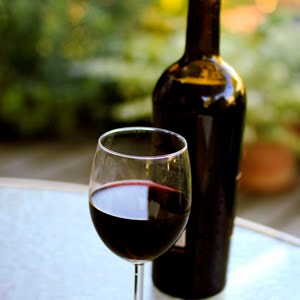Teal Lake was the first and is perhaps the most famous of the Australian kosher wineries. Their standard offerings (at around $14/bottle) typify the Australian style of big, fruit-forward and very easily enjoyable.
Australian wines fall into the category of "New World" winemaking styles because of the emphasis on fruit in the wine and de-emphasizing the earthier and more rustic aspects of wines normally found in their European counterparts. Also, and more importantly, there is a lack of restrictions on winemaking in New World regions as compared to their "Old World" counterparts. In Europe, there is a system of appellation of origin (AOC in France, DO in Spain and Portugal, DOC/DOCG in Italy) that guarantees the consumer that the contents of a given bottle will have certain grapes, aging etc. In other words, in France to have the title "Appellation Bordeaux Controllee") you must have a wine that is made up of predominantly Cabernet Sauvignon, Merlot and Cabernet Franc, with some other grapes such as Petit Verdot, Malbec and Tannat allowed in the blend in small amounts. If you wanted to make a wine based on Pinot Noir in Bordeaux, you would not be allowed to have an AOC Bordeaux label on your wine. So not only does the appellation of origin guarantee the location of the wine's production but also what is in the wine, etc.
If I wanted to make a Cabernet-based wine in Burgundy, for example, I would have to "declassify" my wine into a "lower" level of production, usually "Vin de Pays" (a translation of that phrase is "country wine"). Under Vin de Pays and lower classifications of wine, there is more freedom in the grapes used to make a given wine, but the wine maker is not allowed to use a more specific designation to describe the wine's geographic origins. Furthermore, many Vin de Pays are restricted in the prices they can charge for said wine.
By contrast, New World wines don't have these kinds of restrictions on their winemaking. While there is still some appellation control involved in the New World, its focus is primarily on the geography of the wine; it guarantees that your wine is from Napa Valley, and not, say from Sonoma or Oregon. But beyond those restrictions, there is not much the law says about the wines New World wine makers produce. They have the freedom to make wines from whatever grapes they want, in whatever proportions desired. As a wine maker I can use my vineyard to grow Cabernet Sauvignon (classically grown in warmer Bordeaux) but then if I want, I can rip out the vines and grow Pinot Noir (classically from cooler-climate Burgundy) in the same plot of land. I can age the wine as long as I want in whatever kind of container (from small oak barrels to massive stainless steel tanks) I should choose.
The most famous grape in the Australian vineyard is Shiraz, which most people don't realize is the exact same grape as Syrah from the Rhone region of France. However, despite being the same grape, there are distinct differences between them that could justify the name change. Whereas French Syrah is typically earthy and spicy as its predominant characteristics, Australian wine makers typically emphasize the fruit flavors of the wine by allowing the grapes to mature until the last possible moment before picking. Furthermore, many Australian wine makers use new oak barrels and/or oak chips in older barrels to give their wines a more oaky flavor (you'd notice strong vanilla, buterscotch and smoky aromas/flavors in the wine).
Now, let's turn our attention to the main character in today's post: Teal Lake Cab Sauv Reserve 2004. I had this wine in January 2011 so the wine itself is 7 years old! That is an unusual marker for any modern-styled wine to be able to age that long, and it's important to note that it has only been available on the market for a few months now, so it's not a wine that just sat on shelves and no one bought. It was aged and then released at the winery's discretion.
My tasting of this wine was a very confusing one because I was getting notes that I would have expected from an older wine while still getting some qualities that are typical for Australian wines. On the nose I smelled fresh jammy fruits right off. The fact that this quality was present at all, let alone the predominant aroma was quite confusing to me. When a wine ages, the fresh fruity qualities that are present in a younger wine disappear. For example, instead of fresh jammy plums in a young wine, one would get the essence of dried or preserved fruit (ie, prunes). However, in the Teal Lake 2004 I was able to distinctly smell the fresh cherries and blueberries in the wine. In the background there were some tell-tale earthy and musty qualities that are typical in older wines, which were pleasant in their own right.
On the palate these seemingly conflicting experiences continued. I tasted ripe strawberries initially but they gave way to green pepper and leathery notes with a relatively short finish. There was enough tannin to the wine that it has the potential to go with something like a burger (or something else on the barbie) but not enough acidity for me to call it hearty food wine. I think it is enjoyable on its own as a sipper in the middle of the day as a starter for a longer dinner.
Overall, despite the confusion this wine brought to my nose and palate, I thought it was a very intriguing wine that both confirmed and denied its age (can you do botox on a bottle of wine?). I would hope that some of my readers would buy a bottle themselves and tell me their thoughts on the bottle. It goes for around $20 on store shelves.
L'chayim!

No comments:
Post a Comment